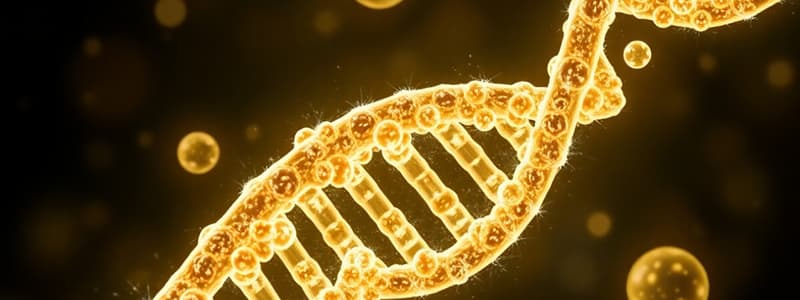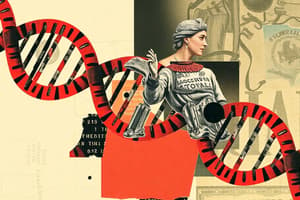Podcast
Questions and Answers
What is the main function of DNA polymerase I during DNA replication?
What is the main function of DNA polymerase I during DNA replication?
- To unwind the double helix
- To proofread the newly synthesized DNA
- To synthesize the leading strand
- To replace RNA primers with DNA (correct)
Which statement correctly describes the synthesis of the lagging strand during DNA replication?
Which statement correctly describes the synthesis of the lagging strand during DNA replication?
- It requires multiple RNA primers to initiate synthesis (correct)
- It is synthesized in a single long continuous piece
- It is synthesized before the leading strand
- It is synthesized continuously in the 5′ to 3′ direction
What are Okazaki fragments?
What are Okazaki fragments?
- Long continuous stretches of DNA synthesized without interruption
- Pieces of DNA that are removed during mismatch repair
- Short DNA segments synthesized on the lagging strand (correct)
- Segments of RNA used during leading strand synthesis
How does the antiparallel structure of DNA influence replication?
How does the antiparallel structure of DNA influence replication?
What role does primase play in DNA replication?
What role does primase play in DNA replication?
What is the primary function of DNA polymerase III during DNA replication?
What is the primary function of DNA polymerase III during DNA replication?
Which strand is synthesized continuously during DNA replication?
Which strand is synthesized continuously during DNA replication?
What are Okazaki fragments?
What are Okazaki fragments?
What role does primase play in DNA replication?
What role does primase play in DNA replication?
Which of the following describes the antiparallel nature of DNA strands?
Which of the following describes the antiparallel nature of DNA strands?
During which phase does primase synthesize RNA primers?
During which phase does primase synthesize RNA primers?
How does DNA polymerase III contribute to the process of linking Okazaki fragments?
How does DNA polymerase III contribute to the process of linking Okazaki fragments?
What happens to DNA polymerase III after it has synthesized a fragment?
What happens to DNA polymerase III after it has synthesized a fragment?
What is the primary role of DNA polymerases in DNA synthesis?
What is the primary role of DNA polymerases in DNA synthesis?
In which direction can DNA polymerase synthesize a new DNA strand?
In which direction can DNA polymerase synthesize a new DNA strand?
What is the function of primase during DNA replication?
What is the function of primase during DNA replication?
What are Okazaki fragments?
What are Okazaki fragments?
How does DNA polymerase I contribute to DNA synthesis?
How does DNA polymerase I contribute to DNA synthesis?
Why is the DNA structure described as antiparallel?
Why is the DNA structure described as antiparallel?
What initiates the synthesis of a new DNA strand during replication?
What initiates the synthesis of a new DNA strand during replication?
What triggers the addition of nucleotides to a growing DNA strand?
What triggers the addition of nucleotides to a growing DNA strand?
What type of reaction occurs when each nucleotide is added to a growing DNA strand?
What type of reaction occurs when each nucleotide is added to a growing DNA strand?
Which statement accurately describes the leading strand during DNA replication?
Which statement accurately describes the leading strand during DNA replication?
What is the primary function of DNA polymerase I in the process of DNA replication?
What is the primary function of DNA polymerase I in the process of DNA replication?
Which statement accurately describes the synthesis of Okazaki fragments?
Which statement accurately describes the synthesis of Okazaki fragments?
What role does the RNA primer play in DNA replication?
What role does the RNA primer play in DNA replication?
How do the leading and lagging strands differ during DNA replication?
How do the leading and lagging strands differ during DNA replication?
What property of DNA allows for the formation of Okazaki fragments?
What property of DNA allows for the formation of Okazaki fragments?
Why is the synthesis of RNA primers critical in the replication process?
Why is the synthesis of RNA primers critical in the replication process?
In which cellular process are Okazaki fragments primarily involved?
In which cellular process are Okazaki fragments primarily involved?
What happens to Okazaki fragments after they are synthesized?
What happens to Okazaki fragments after they are synthesized?
Which enzyme is responsible for the synthesis of the RNA primer for Okazaki fragments?
Which enzyme is responsible for the synthesis of the RNA primer for Okazaki fragments?
What is the directionality of the synthesis of the leading strand during DNA replication?
What is the directionality of the synthesis of the leading strand during DNA replication?
Flashcards are hidden until you start studying
Study Notes
DNA Polymerase & Replication
- DNA Polymerases add nucleotides to a DNA strand
- Require a primer to which they can add nucleotides
- The initial nucleotide strand is a short RNA primer
- The RNA primer is synthesized by the enzyme primase
- A primer is short (5-10 nucleotides long), and the 3’ end serves as the starting point for the new DNA strand
- Each nucleotide that is added to a growing DNA strand is a nucleoside triphosphate
- As each monomer joins the DNA strand, via a dehydration reaction, it loses two phosphate groups as a molecule of pyrophosphate
- DNA Polymerase I eventually replaces RNA primers with DNA
- DNA Polymerase can ONLY build DNA in the 5’ 3’ direction on the new strand
Antiparallel Elongation
- DNA polymerases add nucleotides only to the free 3′ end of a growing strand
- Therefore, a new DNA strand can elongate only in the 5′ to 3′ direction
- Along one template strand of DNA, the DNA polymerase synthesizes a leading strand continuously, moving toward the replication fork
- To elongate the other new strand, called the lagging strand, DNA polymerase must work in the direction away from the replication fork
- The lagging strand is synthesized as a series of segments called Okazaki fragments, which are joined together by DNA ligase
DNA Replication Process
- Primase makes RNA primer.
- DNA pol III makes Okazaki fragment 1.
- DNA pol III detaches.
- Okazaki Fragment one is primed.
- DNA pol I replaces RNA with DNA.
- DNA ligase forms bonds between DNA fragments.
- The lagging strand is complete.
Proteins Involved in DNA Replication
- Helicases: Unwind the DNA double helix, separating the two strands
- Primase: Synthesizes short RNA primers, which are necessary for DNA polymerase to initiate DNA synthesis.
- Topoisomerase: Relieves the strain in the DNA molecule caused by unwinding.
- DNA Polymerase III: Adds nucleotides to the 3' end of a growing DNA strand, synthesizing the new DNA strand, performs most of the DNA synthesis in a cell.
- DNA Polymerase I: Replaces the RNA primers with DNA nucleotides during replication.
- DNA ligase: Joins the Okazaki fragments together on the lagging strand, forming a continuous DNA strand.
- Single strand binding proteins: Bind to single-stranded DNA, preventing them from re-annealing back together until replication is complete.
The DNA Replication Complex
- The proteins that participate in DNA replication form a large stationary complex, a “DNA replication machine”
- The DNA moves through the complex during replication.
- Primase can act as a molecular break.
Proofreading & Repairing DNA
- DNA polymerases proofread newly made DNA, replacing any incorrect nucleotides
- In mismatch repair of DNA, repair enzymes correct errors in base pairing
- DNA can be damaged by exposure to harmful chemical or physical agents such as cigarette smoke and X-rays; it can also undergo spontaneous changes
- In nucleotide excision repair, a nuclease cuts out and replaces damaged stretches of DNA
Studying That Suits You
Use AI to generate personalized quizzes and flashcards to suit your learning preferences.




